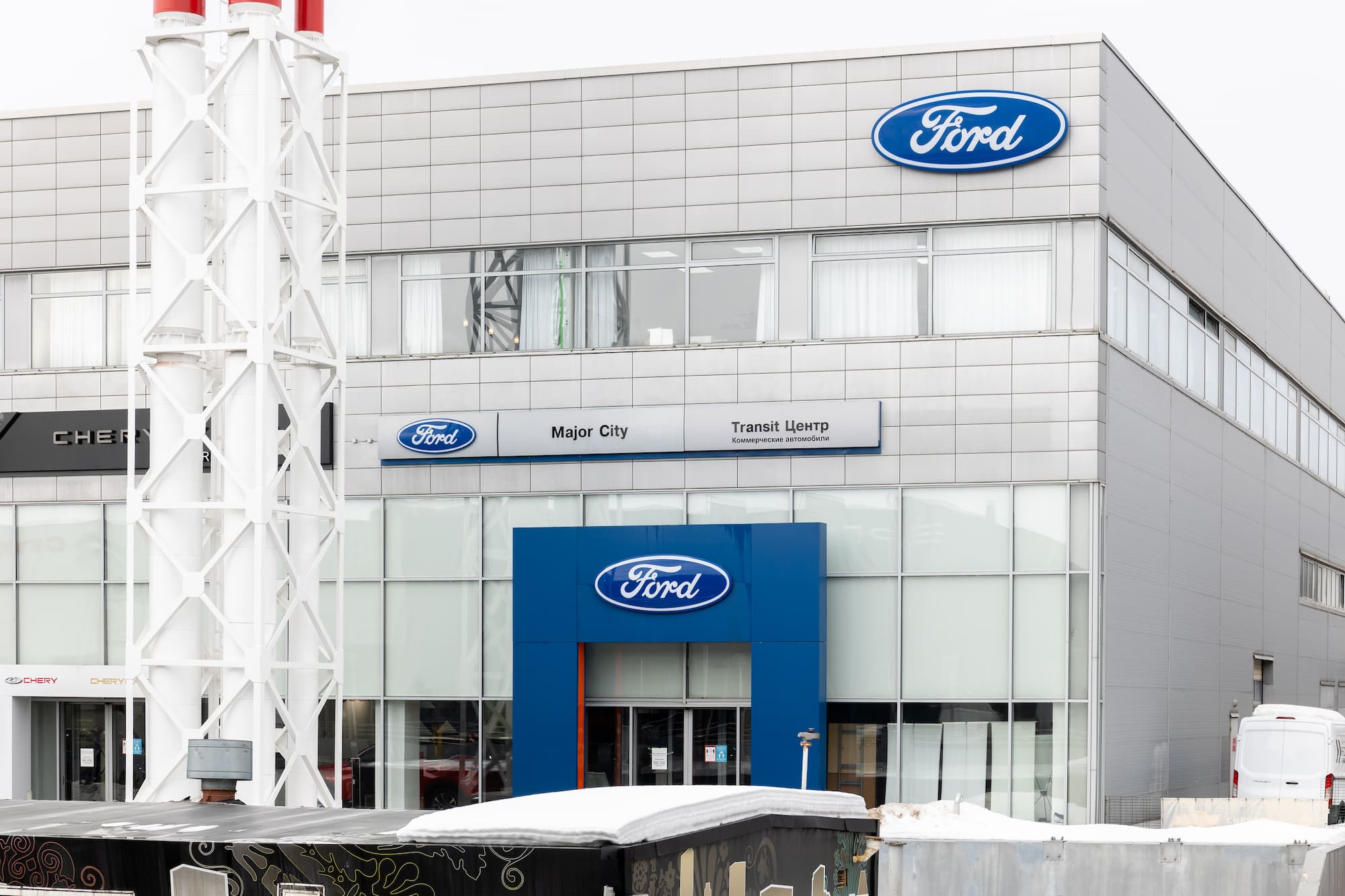Посмотреть инструкция для Ford Transit (2020) бесплатно. Руководство относится к категории автомобили, 6 человек(а) дали ему среднюю оценку 8. Руководство доступно на следующих языках: английский. У вас есть вопрос о Ford Transit (2020) или вам нужна помощь? Задайте свой вопрос здесь
Не можете найти ответ на свой вопрос в руководстве? Вы можете найти ответ на свой вопрос ниже, в разделе часто задаваемых вопросов о Ford Transit (2020).
Как перевести мили в километры?
Где я могу узнать идентификационный номер транспортного средства Ford?
Что такое идентификационный номер транспортного средства (VIN)?
Когда транспортному средству Ford требуется техническое обслуживание?
Когда следует заменять тормозную жидкость на Ford?
В чем разница между топливом E10 и E5?
Одна или несколько дверей не открываются изнутри. Что мне делать?
Автомобильный радиоприемник не включается, что делать?
Инструкция Ford Transit (2020) доступно в русский?
Не нашли свой вопрос? Задайте свой вопрос здесь
Используемые в ролике про установку фаркопа мануалы по Форд Транзит:
Мануал Форд Транзит Кастом (Ford Transit Custom)
Монтаж оборудования на Форд Транзит 2014+
Мануал Форд Транзит на русском (короткая версия)
Мануал Форд Транзит на русском (полная версия)
Найти их и скачать абсолютно бесплатно можно на моей страничке: onehat.ru/posts/10-pro-fa…instrukcii-i-manualy.html
Надеюсь эта информация будет вам полезна!
Цена вопроса: 0 ₽
Пробег: 3 773 км
Руководства по эксплуатации автомобилей
В этом разделе Вы можете получить руководство по эксплуатации для Вашего автомобиля марки Ford. Для просмотра руководства Вам необходимо нажать на ссылку «Скачать» около нужной модели, получив таким образом файл в формате PDF.
Transit Connect
Руководство по эксплуатации
Облегченная версия (PDF, 3.16 Мб)
Версия для печати (PDF, 27.2 Мб)
Tourneo Connect
Руководство по эксплуатации
Облегченная версия (PDF, 3.16 Мб)
Версия для печати (PDF, 27.2 Мб)
Transit
Руководство по эксплуатации
Облегченная версия (PDF, 5.83 Мб)
Версия для печати (PDF, 42.0 Мб)
Ranger
Руководство по эксплуатации
Облегченная версия (PDF, 7.75 Мб)
Версия для печати (PDF, 24.8 Мб)
Подробную информацию узнавайте в автосалонах Major Ford:
Ford Новорижский
Новорижское ш. 9 км от МКАД
ежедневно с 8.00 до 21.00
продажи с 9.00 до 21.00
+7 (495) 116-76-23
salesfordnr@major-auto.ru
Вы можете продолжить просмотр:
- Перейти на главную страницу
- Перейти в раздел «Автомобили в наличии»
- Перейти в раздел «Ford с пробегом»
- Перейти в раздел «Вопросы и ответы»
Смотреть руководство для Ford Transit (2020) ниже. Все руководства на ManualsCat.com могут просматриваться абсолютно бесплатно. Нажав кнопку «Выбор языка» вы можете изменить язык руководства, которое хотите просмотреть.
MANUALSCAT | RU
Вопросы и ответы
У вас есть вопрос о Ford Transit (2020), но вы не можете найти ответ в пользовательском руководстве? Возможно, пользователи ManualsCat.com смогут помочь вам и ответят на ваш вопрос. Заполните форму ниже — и ваш вопрос будет отображаться под руководством для Ford Transit (2020). Пожалуйста, убедитесь, что вы опишите свои трудности с Ford Transit (2020) как можно более детально. Чем более детальным является ваш вопрос, тем более высоки шансы, что другой пользователь быстро ответит на него. Вам будет автоматически отправлено электронное письмо, чтобы проинформировать вас, когда кто-то из пользователей ответит на ваш вопрос.
Добрый день. Подскажите пожалуйста, какая маркировка фильтра очистки топлива форд транзит 2,2л дизель?
Николай2023-01-18
Задать вопрос о Ford Transit (2020)
- Бренд:
- Ford
- Продукт:
- автомобили
- Модель/название:
- Transit (2020)
- Тип файла:
- Доступные языки:
- английский
Сопутствующие товары Ford Transit (2020)

September 2019
First Printing
Litho in U.S.A.
2020 TRANSIT Owner’s Manual
Owner’s Manual 2020TRANSIT
LK3J 19A321 AA

The information contained in this publication was correct at the time of going to print. In the interest of continuous development, we reserve the right to change specifications, design or equipment at any time without notice or obligation. No part of this publication may be reproduced, transmitted, stored in a retrieval system or translated into any language in any form by any means without our written permission. Errors and omissions excepted.
© Ford Motor Company 2019
All rights reserved.
Part Number: LK3J 19A321 AA 201908 20190823091629
California Proposition 65


Wash your hands after handling.


Table of Contents
|
Introduction |
|
|
About This Manual …………………………………… |
9 |
|
Symbols Glossary …………………………………….. |
9 |
|
Data Recording …………………………………………. |
11 |
|
Perchlorate ………………………………………………. |
15 |
|
Replacement Parts Recommendation |
|
|
………………………………………………………………… |
16 |
|
Special Notices ……………………………………….. |
16 |
|
Mobile Communications Equipment |
|
|
………………………………………………………………… |
18 |
|
Export Unique Options ………………………….. |
18 |
|
Environment |
|
|
Protecting the Environment ………………….. |
19 |
|
Child Safety |
|
|
General Information ………………………………. |
20 |
|
Installing Child Restraints …………………….. |
22 |
|
Booster Seats …………………………………………. |
38 |
|
Child Restraint Positioning …………………… |
40 |
|
Child Safety Locks …………………………………. |
42 |
|
Seatbelts |
|
|
Principle of Operation …………………………… |
44 |
|
Fastening the Seatbelts ……………………….. |
45 |
|
Seatbelt Height Adjustment ………………… |
47 |
|
Seatbelt Warning Lamp and Indicator |
|
|
Chime ……………………………………………………. |
47 |
|
Seatbelt Reminder ………………………………… |
48 |
|
Child Restraint and Seatbelt |
|
|
Maintenance ………………………………………. |
50 |
|
Seatbelt Extensions ………………………………. |
50 |
|
Supplementary Restraints |
|
|
System |
|
|
Principle of Operation ……………………………. |
51 |
|
Driver and Passenger Airbags ………………. |
52 |
|
Side Airbags ……………………………………………. |
58 |
|
Safety Canopy™ ……………………………………. |
59 |
|
Crash Sensors and Airbag Indicator …… |
60 |
|
Airbag Disposal ……………………………………….. |
61 |
|
911 Assist |
|
|
What Is 911 Assist …………………………………… |
62 |
|
Emergency Call Requirements ……………. |
62 |
|
Emergency Call Limitations …………………. |
63 |
|
Keys and Remote Controls |
|
|
Principle of Operation …………………………… |
64 |
|
General Information on Radio |
|
|
Frequencies ………………………………………… |
64 |
|
Remote Control — Vehicles Without: |
|
|
Passive Anti-Theft System (PATS) |
|
|
……………………………………………………………….. |
65 |
|
Remote Control — Vehicles With: Passive |
|
|
Anti-Theft System (PATS) ……………….. |
66 |
|
Remote Control — Vehicles With: Power |
|
|
Sliding Door ………………………………………… |
68 |
|
Replacing a Lost Key or Remote Control |
|
|
………………………………………………………………… |
70 |
|
MyKey™ |
|
|
Principle of Operation …………………………….. |
71 |
|
MyKey Settings ………………………………………… |
71 |
|
Creating a MyKey ……………………………………. |
72 |
|
Programming a MyKey ………………………….. |
72 |
|
Clearing All MyKeys ……………………………….. |
74 |
|
Checking MyKey System Status ………….. |
74 |
|
Using MyKey With Remote Start |
|
|
Systems ……………………………………………….. |
75 |
|
MyKey – Troubleshooting ……………………… |
75 |
|
Doors and Locks |
|
|
Locking and Unlocking ………………………….. |
76 |
|
Sliding Door — Vehicles |
|
|
Without:PowerSlidingDoor |
|
|
Sliding Door Precautions ……………………… |
80 |
|
Opening the Sliding Door …………………….. |
80 |
|
Closing the Sliding Door ………………………… |
81 |
1
2020 Transit (TTH) Canada/United States of America, LK3J 19A321 AA enUSA, Edition date: 201908, First-Printing

Table of Contents
|
Sliding Door — Vehicles With: |
|
|
Power Sliding Door |
|
|
Sliding Door Precautions ……………………… |
82 |
|
Opening the Sliding Door ……………………… |
82 |
|
Closing the Sliding Door ……………………….. |
83 |
|
Stopping the Sliding Door Movement |
|
|
……………………………………………………………….. |
84 |
|
Resetting the Power Sliding Door ………. |
84 |
|
Sliding Door – Troubleshooting ………….. |
85 |
|
Keyless Entry |
|
|
Locating the Keyless Entry Keypad …….. |
87 |
|
Master Access Code ………………………………. |
87 |
|
Keyless Entry Settings …………………………… |
87 |
|
Locking and Unlocking the Doors Using |
|
|
Keyless Entry ……………………………………….. |
87 |
|
Keyless Entry – Troubleshooting ………… |
88 |
|
Security |
|
|
Passive Anti-Theft System — Vehicles |
|
|
With: Passive Anti-Theft System |
|
|
(PATS) …………………………………………………. |
89 |
|
Anti-Theft Alarm — Vehicles Without: |
|
|
Anti-Theft Alarm Horn with Integral |
|
|
Battery …………………………………………………. |
90 |
|
Anti-Theft Alarm — Vehicles With: |
|
|
Anti-Theft Alarm Horn with Integral |
|
|
Battery ………………………………………………….. |
91 |
|
Power Running Boards |
|
|
Using Power Running Boards ………………. |
93 |
|
Steering Wheel |
|
|
Adjusting the Steering Wheel ……………… |
96 |
|
Wipers and Washers |
|
|
Windshield Wipers …………………………………. |
97 |
|
Autowipers ………………………………………………. |
97 |
|
Windshield Washers ……………………………… |
98 |
2
|
Lighting |
|
|
General Information ……………………………. |
100 |
|
Lighting Control ……………………………………. |
100 |
|
Autolamps ……………………………………………… |
101 |
|
Instrument Lighting Dimmer ………………. |
102 |
|
Daytime Running Lamps …………………….. |
102 |
|
Automatic High Beam Control …………… |
103 |
|
Front Fog Lamps ………………………………….. |
104 |
|
Direction Indicators ……………………………… |
105 |
|
Interior Lamps ………………………………………. |
105 |
|
Cargo Lamps ………………………………………… |
106 |
|
Windows and Mirrors |
|
|
Power Windows ……………………………………. |
107 |
|
Exterior Mirrors ……………………………………… |
108 |
|
Interior Mirror ………………………………………… |
109 |
|
Instrument Cluster |
|
|
Gauges ……………………………………………………. |
110 |
|
Warning Lamps and Indicators ……………. |
111 |
|
Information Displays |
|
|
General Information ……………………………… |
115 |
|
Trip Computer ………………………………………… |
117 |
|
Personalized Settings …………………………… |
119 |
|
Climate Control |
|
|
Manual Climate Control ……………………….. |
121 |
|
Hints on Controlling the Interior Climate |
|
|
………………………………………………………………. |
122 |
|
Rear Passenger Climate Controls ………. |
123 |
|
Heated Rear Window …………………………… |
123 |
|
Heated Exterior Mirrors — Vehicles |
|
|
Without: Heated Rear Window ………. |
123 |
|
Heated Exterior Mirrors — Vehicles With: |
|
|
Heated Rear Window ……………………….. |
123 |
|
Auxiliary Heater …………………………………….. |
124 |
|
Remote Start …………………………………………. |
125 |
2020 Transit (TTH) Canada/United States of America, LK3J 19A321 AA enUSA, Edition date: 201908, First-Printing

Table of Contents
|
Interior Air Quality |
|
|
What Is the Cabin Air Filter ………………….. |
127 |
|
Locating the Cabin Air Filter ………………… |
127 |
|
Changing the Cabin Air Filter ………………. |
127 |
|
Seats |
|
|
Sitting in the Correct Position …………….. |
128 |
|
Head Restraints …………………………………….. |
128 |
|
Manual Seats — Vehicles With: 2-Way |
|
|
Manual Seat ………………………………………. |
129 |
|
Manual Seats — Vehicles With: 4-Way |
|
|
Manual Seat ……………………………………….. |
131 |
|
Power Seats …………………………………………… |
133 |
|
Rear Seats ……………………………………………… |
135 |
|
Heated Seats ………………………………………… |
138 |
|
Auxiliary Power Points |
|
|
Auxiliary Power Points …………………………. |
139 |
|
Cigar Lighter …………………………………………… |
141 |
|
Storage Compartments |
|
|
Overhead Console ………………………………… |
142 |
|
Bottle Holders ……………………………………….. |
142 |
|
Overhead Storage ………………………………… |
142 |
|
Rear Overhead Storage ……………………….. |
142 |
|
Starting and Stopping the |
|
|
Engine |
|
|
General Information …………………………….. |
144 |
|
Ignition Switch ………………………………………. |
144 |
|
Steering Wheel Lock ……………………………. |
145 |
|
Starting a Gasoline Engine …………………. |
145 |
|
Starting a Diesel Engine ………………………. |
146 |
|
Switching Off the Engine ……………………. |
148 |
|
Engine Block Heater …………………………….. |
148 |
|
Auto-Start-Stop — 3.5L |
|
|
Ecoboost™, 2.0L EcoBlue |
|
|
What Is Auto-Start-Stop …………………….. |
150 |
|
Auto-Start-Stop Precautions …………….. |
150 |
3
|
Switching Auto-Start-Stop On and Off |
|
|
………………………………………………………………. |
150 |
|
Stopping the Engine …………………………….. |
150 |
|
Restarting the Engine ………………………….. |
150 |
|
Auto-Start-Stop Indicators …………………. |
151 |
|
Auto-Start-Stop – Troubleshooting |
|
|
……………………………………………………………….. |
151 |
|
Fuel and Refueling |
|
|
Safety Precautions ……………………………….. |
153 |
|
Fuel Quality — 2.0L EcoBlue, Diesel ……. |
153 |
|
Fuel Quality — 3.5L Duratec, E85 ………… |
156 |
|
Fuel Quality — 3.5L Duratec/3.5L |
|
|
Ecoboost™, Gasoline ……………………….. |
157 |
|
Fuel Filler Funnel Location ………………….. |
158 |
|
Running Out of Fuel …………………………….. |
158 |
|
Refueling ………………………………………………… |
159 |
|
Engine Emission Control |
|
|
Emission Law ………………………………………… |
163 |
|
Catalytic Converter — 3.5L Duratec/3.5L |
|
|
Ecoboost™ ………………………………………… |
164 |
|
Selective Catalytic Reductant System — |
|
|
2.0L EcoBlue ……………………………………… |
165 |
|
Diesel Particulate Filter ……………………….. |
168 |
|
Transmission |
|
|
Automatic Transmission ……………………… |
174 |
|
Tow/Haul ……………………………………………….. |
176 |
|
All-Wheel Drive |
|
|
Using All-Wheel Drive ………………………….. |
178 |
|
Brakes |
|
|
General Information …………………………….. |
183 |
|
Hints on Driving With Anti-Lock Brakes |
|
|
………………………………………………………………. |
183 |
|
Hill Start Assist ……………………………………… |
183 |
2020 Transit (TTH) Canada/United States of America, LK3J 19A321 AA enUSA, Edition date: 201908, First-Printing

Table of Contents
Parking Brake — Vehicles With:
Conventional Mechanical
Parking Brake
|
Applying the Parking Brake ……………….. |
186 |
|
Releasing the Parking Brake ……………… |
186 |
|
Parking Brake Audible Warning …………. |
186 |
|
Parking Brake – Troubleshooting ………. |
186 |
|
Parking Brake — Vehicles With: |
|
|
Push Down Parking Brake |
|
|
Applying the Parking Brake ………………… |
187 |
|
Releasing the Parking Brake ………………. |
187 |
|
Pushing the Parking Brake Lever Down |
|
|
………………………………………………………………. |
187 |
|
Parking Brake Audible Warning ………….. |
187 |
|
Parking Brake – Troubleshooting ………. |
188 |
|
Traction Control |
|
|
Principle of Operation …………………………. |
189 |
|
Using Traction Control ………………………… |
189 |
|
Stability Control |
|
|
Principle of Operation …………………………. |
190 |
|
Using Stability Control …………………………. |
191 |
|
Parking Aids |
|
|
Principle of Operation ………………………….. |
192 |
|
Parking Aid …………………………………………….. |
192 |
|
Rear Parking Aid …………………………………… |
194 |
|
Front Parking Aid ………………………………….. |
196 |
|
Side Sensing System …………………………… |
198 |
|
Active Park Assist ……………………………….. |
200 |
|
Rear View Camera — Vehicles With: |
|
|
Parking Aid Camera …………………………. |
202 |
|
180 Degree Camera …………………………….. |
205 |
|
Cruise Control |
|
|
Principle of Operation …………………………. |
207 |
|
Using Cruise Control ……………………………. |
207 |
|
Using Adaptive Cruise Control ………….. |
208 |
4
|
Driving Aids |
|
|
Speed Limiter ………………………………………… |
216 |
|
Driver Alert ……………………………………………… |
216 |
|
Lane Keeping System ………………………….. |
219 |
|
Blind Spot Information System …………. |
223 |
|
Cross Traffic Alert ………………………………… |
226 |
|
Eco …………………………………………………………. |
230 |
|
Steering ………………………………………………….. |
231 |
|
Pre-Collision Assist ……………………………… |
232 |
|
Front View Camera ……………………………… |
236 |
|
Drive Control …………………………………………. |
237 |
|
Load Carrying |
|
|
Roof Racks and Load Carriers — Bus ….. |
239 |
|
Roof Racks and Load Carriers — Van |
|
|
……………………………………………………………… |
239 |
|
Load Retaining Fixtures ………………………. |
239 |
|
Load Limit …………………………………………….. |
240 |
|
Towing |
|
|
Towing a Trailer ……………………………………. |
245 |
|
Recommended Towing Weights — |
|
|
Chassis Cab/Crew Van/Cutaway/Van |
|
|
……………………………………………………………… |
246 |
|
Recommended Towing Weights — M2 |
|
|
Bus ……………………………………………………… |
248 |
|
Essential Towing Checks …………………….. |
251 |
|
Towing the Vehicle on Four Wheels …… |
257 |
|
Driving Hints |
|
|
Breaking-In ……………………………………………. |
258 |
|
Reduced Engine Performance …………… |
258 |
|
Economical Driving ……………………………… |
258 |
|
Cold Weather Precautions …………………. |
258 |
|
Driving Through Water ………………………… |
259 |
|
Floor Mats …………………………………………….. |
259 |
|
Roadside Emergencies |
|
|
Roadside Assistance ……………………………. |
261 |
|
Hazard Flashers ……………………………………. |
262 |
2020 Transit (TTH) Canada/United States of America, LK3J 19A321 AA enUSA, Edition date: 201908, First-Printing

Table of Contents
|
Emergency Exit — M2 Bus ……………………. |
262 |
|
Fuel Shutoff ………………………………………….. |
262 |
|
Jump Starting the Vehicle — 2.0L EcoBlue |
|
|
……………………………………………………………… |
263 |
|
Jump Starting the Vehicle — 3.5L |
|
|
Duratec/3.5L Ecoboost™ ………………. |
265 |
|
Post-Crash Alert System ……………………. |
268 |
|
Transporting the Vehicle ……………………. |
268 |
|
Towing Points ………………………………………. |
269 |
|
Customer Assistance |
|
|
Ford Credit …………………………………………….. |
270 |
|
Getting the Services You Need ………….. |
270 |
|
In California (U.S. Only) ……………………….. |
271 |
|
The Better Business Bureau (BBB) Auto |
|
|
Line Program (U.S. Only) ………………… |
272 |
|
Utilizing the Mediation/Arbitration |
|
|
Program (Canada Only) ………………….. |
273 |
|
Getting Assistance Outside the U.S. and |
|
|
Canada ……………………………………………….. |
273 |
|
Ordering Additional Owner’s Literature |
|
|
……………………………………………………………… |
275 |
|
Reporting Safety Defects (U.S. Only) |
|
|
……………………………………………………………… |
275 |
|
Reporting Safety Defects (Canada Only) |
|
|
……………………………………………………………… |
276 |
|
Fuses |
|
|
Fuse Box Locations ………………………………. |
277 |
|
Fuse Specification Chart …………………….. |
278 |
|
Changing a Fuse ………………………………….. |
290 |
|
Maintenance |
|
|
General Information ……………………………. |
292 |
|
Opening and Closing the Hood …………. |
292 |
|
Under Hood Overview — 2.0L EcoBlue |
|
|
……………………………………………………………… |
294 |
|
Under Hood Overview — 3.5L Duratec |
|
|
……………………………………………………………… |
295 |
|
Under Hood Overview — 3.5L Ecoboost™ |
|
|
……………………………………………………………… |
296 |
|
Engine Oil Dipstick — 2.0L EcoBlue ……. |
297 |
|
Engine Oil Dipstick — 3.5L Duratec …….. |
297 |
|
Engine Oil Dipstick — 3.5L Ecoboost™ |
|
|
……………………………………………………………… |
297 |
|
Engine Oil Check ………………………………….. |
297 |
|
Changing the Engine Oil and Oil Filter |
|
|
……………………………………………………………… |
298 |
|
Oil Change Indicator Reset — Diesel …… |
299 |
|
Oil Change Indicator Reset — Gasoline |
|
|
……………………………………………………………..300 |
|
|
Engine Cooling Fan — Diesel ………………. |
300 |
|
Engine Cooling Fan — Gasoline ………….. |
300 |
|
Engine Coolant Check ………………………… |
300 |
|
Automatic Transmission Fluid Check |
|
|
……………………………………………………………..304 |
|
|
Brake Fluid Check ………………………………… |
305 |
|
Fuel Filter Service Indicator Check …… |
305 |
|
Washer Fluid Check …………………………….. |
305 |
|
Draining the Fuel Filter Water Trap …… |
305 |
|
Fuel Filter — Gasoline …………………………… |
306 |
|
Changing the 12V Battery ………………….. |
306 |
|
Checking the Wiper Blades ……………….. |
308 |
|
Changing the Front Wiper Blades ……. |
309 |
|
Adjusting the Headlamps ………………….. |
309 |
|
Removing a Headlamp …………………………. |
311 |
|
Changing a Bulb …………………………………….. |
311 |
|
Changing the Engine Air Filter ……………. |
316 |
|
Drive Belt Routing — 2.0L EcoBlue ………. |
317 |
|
Drive Belt Routing — 3.5L Duratec/3.5L |
|
|
Ecoboost™, Vehicles With: Dual |
|
|
Generators …………………………………………. |
318 |
|
Drive Belt Routing — 3.5L Duratec/3.5L |
|
|
Ecoboost™, Vehicles With: Single |
|
|
Generator …………………………………………… |
318 |
|
Vehicle Care |
|
|
Cleaning Products ………………………………… |
319 |
|
Cleaning the Exterior …………………………… |
320 |
|
Waxing ……………………………………………………. |
321 |
|
Cleaning the Engine …………………………….. |
322 |
|
Cleaning the Windows and Wiper Blades |
|
|
……………………………………………………………… |
322 |
5
2020 Transit (TTH) Canada/United States of America, LK3J 19A321 AA enUSA, Edition date: 201908, First-Printing

Table of Contents
|
Cleaning the Interior ……………………………. |
323 |
|
Cleaning the Instrument Panel and |
|
|
Instrument Cluster Lens ………………….. |
325 |
|
Repairing Minor Paint Damage ………….. |
325 |
|
Cleaning the Wheels …………………………… |
325 |
|
Vehicle Storage ……………………………………. |
326 |
|
Body Styling Kits ………………………………….. |
328 |
|
Wheels and Tires |
|
|
General Information ……………………………. |
329 |
|
Tire Care ………………………………………………… |
330 |
|
Using Winter Tires ……………………………….. |
347 |
|
Using Snow Chains ……………………………… |
348 |
|
Tire Pressure Monitoring System ……… |
349 |
|
Changing a Road Wheel …………………….. |
353 |
|
Lug Nuts ………………………………………………… |
364 |
|
CapacitiesandSpecifications |
|
|
Engine Specifications — 2.0L EcoBlue |
|
|
……………………………………………………………… |
365 |
|
Engine Specifications — 3.5L Duratec |
|
|
…………………………………………………………….. |
366 |
|
Engine Specifications — 3.5L Ecoboost™ |
|
|
……………………………………………………………… |
367 |
|
Motorcraft Parts — 2.0L EcoBlue ……….. |
368 |
|
Motorcraft Parts — 3.5L Duratec ………… |
369 |
|
Motorcraft Parts — 3.5L Ecoboost™ ….. |
370 |
|
Vehicle Identification Number ……………. |
371 |
|
Vehicle Certification Label ………………….. |
372 |
|
Transmission Code Designation ………… |
372 |
|
Capacities and Specifications — 2.0L |
|
|
EcoBlue ………………………………………………. |
373 |
|
Capacities and Specifications — 3.5L |
|
|
Duratec ……………………………………………….. |
377 |
|
Capacities and Specifications — 3.5L |
|
|
Ecoboost™ ……………………………………….. |
383 |
|
Bulb Specification Chart ……………………. |
389 |
|
Connected Vehicle Limitations ………….. |
391 |
|
Connecting the Vehicle to a Mobile |
|
|
Network ……………………………………………… |
391 |
|
Connecting the Vehicle to a Wi-Fi |
|
|
Network ……………………………………………… |
391 |
|
Connected Vehicle – Troubleshooting |
|
|
……………………………………………………………… |
392 |
|
Wi-Fi Hotspot |
|
|
Creating a Wi-Fi Hotspot ……………………. |
394 |
|
Changing the Wi-Fi Hotspot Name or |
|
|
Password …………………………………………… |
394 |
|
Audio System |
|
|
General Information ……………………………. |
395 |
|
Audio Unit — Vehicles Without: SYNC |
|
|
……………………………………………………………… |
395 |
|
Audio Unit — Vehicles With: SYNC 3 …… |
397 |
|
AM/FM Radio — Vehicles Without: SYNC |
|
|
…………………………………………………………….. |
398 |
|
Audio Unit Clock and Date Displays — |
|
|
Vehicles Without: SYNC …………………. |
399 |
|
Connecting a Bluetooth Device — |
|
|
Vehicles Without: SYNC …………………. |
399 |
|
Streaming Bluetooth Audio — Vehicles |
|
|
Without: SYNC …………………………………. |
399 |
|
Playing Media From a USB Device — |
|
|
Vehicles Without: SYNC …………………. |
399 |
|
USB Port ………………………………………………. |
400 |
|
Using Voice Recognition ……………………. |
400 |
|
SYNC™ |
|
|
General Information …………………………….. |
401 |
|
Using Voice Recognition …………………….. |
402 |
|
Using SYNC™ With Your Phone ………. |
404 |
|
SYNC™ Applications and Services …… |
405 |
|
Using SYNC™ With Your Media Player |
|
|
…………………………………………………………….. |
408 |
|
SYNC™ Troubleshooting …………………… |
409 |
|
Connected Vehicle |
SYNC™ 3 |
|
|
Connected Vehicle Requirements …….. |
391 General Information …………………………….. |
418 |
|
6 |
2020 Transit (TTH) Canada/United States of America, LK3J 19A321 AA enUSA, Edition date: 201908, First-Printing

Table of Contents
|
Using Voice Recognition …………………….. |
420 |
|
Entertainment ……………………………………… |
426 |
|
Phone …………………………………………………….. |
436 |
|
Navigation ……………………………………………… |
437 |
|
Apps ………………………………………………………. |
443 |
|
Settings …………………………………………………. |
445 |
|
SYNC™ 3 Troubleshooting ………………… |
447 |
|
Accessories |
|
|
Accessories ………………………………………….. |
460 |
|
Auxiliary Switches ………………………………… |
461 |
|
Ford Protect |
|
|
Ford Protect ………………………………………….. |
462 |
|
Scheduled Maintenance |
|
|
General Maintenance Information …… |
464 |
|
Normal Scheduled Maintenance ……… |
467 |
|
Special Operating Conditions Scheduled |
|
|
Maintenance …………………………………….. |
469 |
|
Scheduled Maintenance Record ………… |
471 |
|
Appendices |
|
|
Electromagnetic Compatibility …………. |
482 |
|
End User License Agreement ……………. |
484 |
|
Declaration of Conformity …………………. |
509 |
7
2020 Transit (TTH) Canada/United States of America, LK3J 19A321 AA enUSA, Edition date: 201908, First-Printing

8
2020 Transit (TTH) Canada/United States of America, LK3J 19A321 AA enUSA, Edition date: 201908, First-Printing
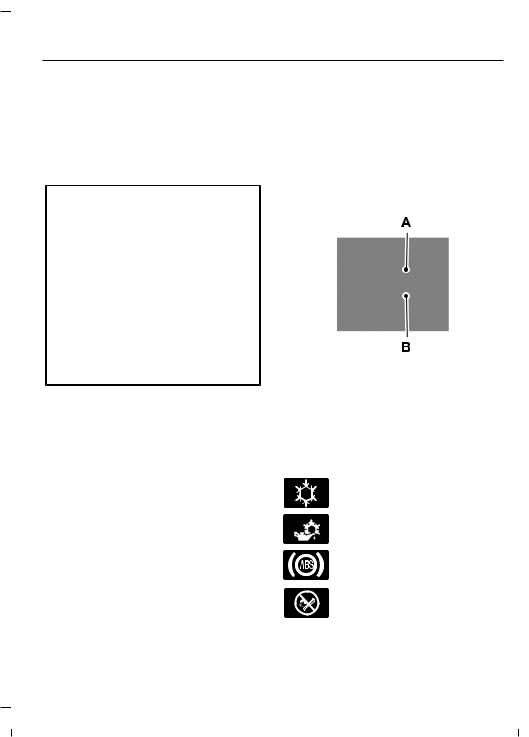
Introduction
ABOUT THIS MANUAL
Thank you for choosing Ford. We recommend that you take some time to get to know your vehicle by reading this manual. The more that you know about your vehicle, the greater the safety and pleasure you will get from driving it.

Note: This manual describes product features and options available throughout the range of available models, sometimes even before they are generally available. It may describe options not fitted to the vehicle you have purchased.
Note: Some of the illustrations in this manual may show features as used in different models, so may appear different to you on your vehicle.
Note: Always use and operate your vehicle in line with all applicable laws and regulations.
Note: Pass on this manual when selling your vehicle. It is an integral part of your vehicle.
Note: Either Ford Motor Company or an authorized Ford dealer may have originally sold this incomplete vehicle to a vehicle modifier who upfitted it. As a result, it may have different options and features than described in this manual.
This manual may qualify the location of a component as left-hand side or right-hand side. The side is determined when facing forward in the seat.
E154903
A Right-hand side.
BLeft-hand side.
SYMBOLS GLOSSARY
These are some of the symbols you may see on your vehicle.
Air conditioning system
Air conditioning system lubricant type
Anti-lock braking system
Avoid smoking, flames or sparks
9
2020 Transit (TTH) Canada/United States of America, LK3J 19A321 AA enUSA, Edition date: 201908, First-Printing
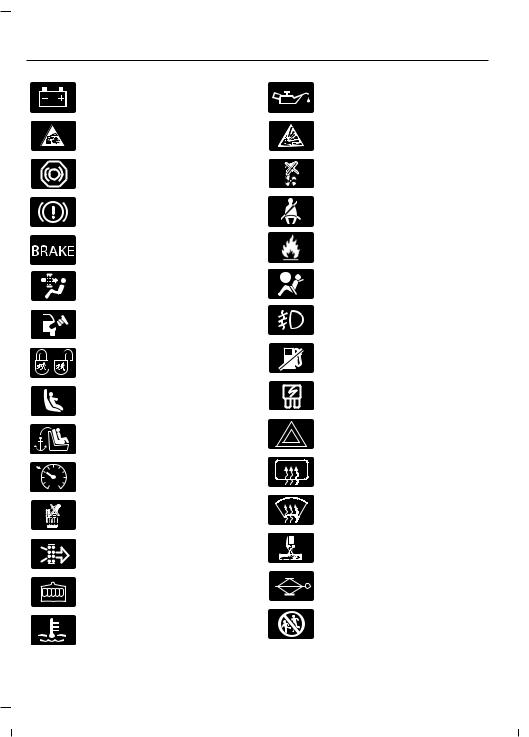
Introduction
Battery
Battery acid
Brake fluid — non petroleum based
Brake system
Brake system
Cabin air filter
Check fuel cap
Child safety door lock or unlock
Child seat lower anchor
Child seat tether anchor
Cruise control
E71340
Do not open when hot
Engine air filter
Engine coolant
Engine coolant temperature
10
Engine oil
Explosive gas
Fan warning
Fasten seatbelt
Flammable
Front airbag
Front fog lamps
Fuel pump reset
Fuse compartment
Hazard flashers
Heated rear window
Windshield defrosting system
Interior luggage compartment release
Jack
Keep out of reach of children
2020 Transit (TTH) Canada/United States of America, LK3J 19A321 AA enUSA, Edition date: 201908, First-Printing
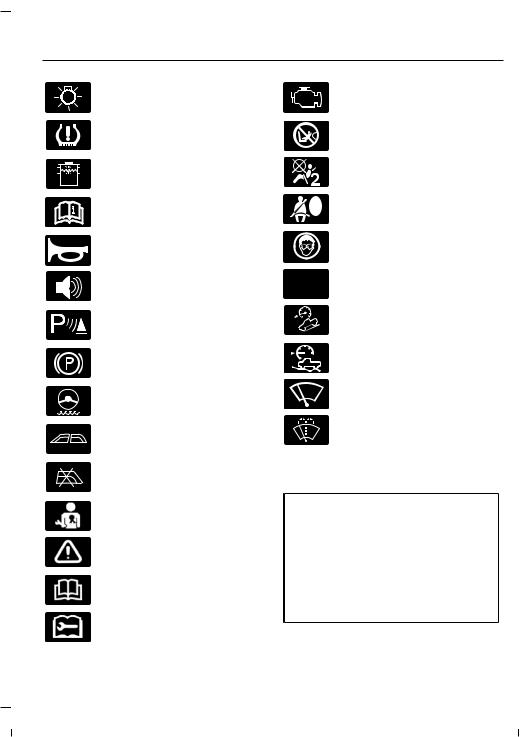
Introduction
Lighting control
Low tire pressure warning
Maintain correct fluid level
Note operating instructions
Horn control
Panic alarm
Parking aid
E139213
Parking brake
Power steering fluid
Power windows front/rear
Power window lockout
Requires registered technician
Safety alert
See Owner’s Manual
See Service Manual
Service engine soon
Passenger airbag activated
Passenger airbag deactivated
Side airbag
Shield the eyes

Hill descent control
Trail control
Windshield wiping system
Windshield wash and wipe
DATA RECORDING

11
2020 Transit (TTH) Canada/United States of America, LK3J 19A321 AA enUSA, Edition date: 201908, First-Printing

Introduction
We respect your privacy and are committed to protecting it. The information contained in this publication was correct at the time of going to print, but as technology rapidly changes, we recommend that you visit the regional Ford website for the latest information.
Your vehicle has electronic control units that have data recording functionality and the ability to permanently or temporarily store data. This data could include information on the condition and status of your vehicle, vehicle maintenance requirements, events and malfunctions. The types of data that can be recorded are described in this section. Some of the data recorded is stored in event logs or error logs.
Note: Error logs are reset following a service or repair.
Note: We may provide information in response to requests from law enforcement, other government authorities and third parties acting with lawful authority or through a legal process. Such information could be used by them in legal proceedings.
Data recorded includes, for example:
•Operating states of system components, for example, fuel level, tire pressure and battery charge level.
•Vehicle and component status, for example, wheel speed, deceleration, lateral acceleration and seatbelt status.
•Events or errors in essential systems, for example, headlamps and brakes.
•System responses to driving situations, for example, airbag deployment and stability control.
•Environmental conditions, for example, temperature.
12
Some of this data, when used in combination with other information, for example, an accident report, damage to a vehicle or eyewitness statements, could be associated with a specific person.
Service Data
Service data recorders in your vehicle are capable of collecting and storing diagnostic information about your vehicle. This potentially includes information about the performance or status of various systems and modules in the vehicle, such as engine, throttle, steering or brake systems. In order to properly diagnose and service your vehicle, Ford Motor Company (Ford of Canada in Canada), and service and repair facilities may access or share among them vehicle diagnostic information received through a direct connection to your vehicle when diagnosing or servicing your vehicle. Additionally, Ford Motor Company (Ford of Canada, in Canada) may, where permitted by law, use vehicle diagnostic information for vehicle improvement or with other information we may have about you, for example, your contact information, to offer you products or services that may interest you. Data may be provided to our service providers such as part suppliers that may help diagnose malfunctions, and who are similarly obligated to protect data. We retain this data only as long as necessary to perform these functions or to comply with law. We may provide information where required in response to official requests to law enforcement or other government authorities or third parties acting with lawful authority or court order, and such information may be used in legal proceedings. For U.S. only (if equipped), if you choose to use connected apps and services, you consent that certain diagnostic information may also be accessed electronically by Ford Motor Company and Ford authorized service
2020 Transit (TTH) Canada/United States of America, LK3J 19A321 AA enUSA, Edition date: 201908, First-Printing

Introduction
facilities, and that the diagnostic information may be used to provide services to you, personalizing your experience, troubleshoot, and to improve products and services and offer you products and services that may interest you, where permitted by law. For Canada only, for more information, please review the Ford of Canada privacy policy at www.ford.ca, including our U.S. data storage and use of service providers in other jurisdictions who may be subject to legal requirements in Canada, the United States and other countries applicable to them, for example, lawful requirements to disclose personal information to governmental authorities in those countries.
Event Data
This vehicle is equipped with an event data recorder. The main purpose of an event data recorder is to record, in certain crash or near crash-like situations, such as an airbag deployment or hitting a road obstacle; this data assist in understanding how a vehicle’s systems performed. The event data recorder is designed to record data related to vehicle dynamics and safety systems for a short period of time, typically 30 seconds or less.
The event data recorder in this vehicle is designed to record such data as:
•How various systems in your vehicle were operating;
•Whether or not the driver and passenger seatbelts were buckled/fastened;
•How far (if at all) the driver was depressing the accelerator and/or the brake pedal; and
•How fast the vehicle was traveling; and
•Where the driver was positioning the steering wheel.
13
This data can help provide a better understanding of the circumstances in which crashes and injuries occur.
Note: Event data recorder data is recorded by your vehicle only if a non-trivial crash situation occurs; no data is recorded by the event data recorder under normal driving conditions and no personal data or information (e.g., name, gender, age, and crash location) is recorded. However, other parties, such as law enforcement, could combine the event data recorder data with the type of personally identifying data routinely acquired during a crash investigation.
To read data recorded by an event data recorder, special equipment is required, and access to the vehicle or the event data recorder is needed. In addition to the vehicle manufacturer, other parties, such as law enforcement, that have such special equipment, can read the information if they have access to the vehicle or the event data recorder.
Comfort, Convenience and
Entertainment Data
Your vehicle has electronic control units that have the ability to store data based on your personalized settings. The data is stored locally in the vehicle or on devices that you connect to it, for example, a USB drive or digital music player. You can delete some of this data and also choose whether to share it through the services to which you subscribe. See Settings (page 445).
Comfort and Convenience Data
Data recorded includes, for example:
•Seat and steering wheel position.
•Climate control settings.
•Radio presets.
2020 Transit (TTH) Canada/United States of America, LK3J 19A321 AA enUSA, Edition date: 201908, First-Printing
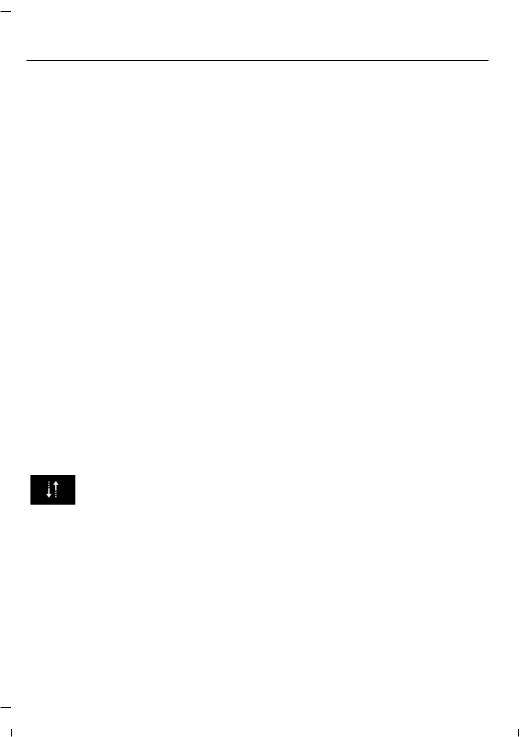
Introduction
Entertainment Data
Data recorded includes, for example:
•Music, videos or album art.
•Contacts and corresponding address book entries.
•Navigation destinations.
Services That We Provide
If you use our services, we collect and use data, for example, account information, vehicle location and driving characteristics, that could identify you. We transmit this data through a dedicated, protected connection. We only collect and use data to enable your use of our services to which you have subscribed, with your consent or where permitted by law. For additional information, see the terms and conditions of the services to which you have subscribed.
Services That Third Parties
Provide
We recommend that you review the terms and conditions and data privacy information for any services to which you subscribe. We take no responsibility for services that third parties provide.
Vehicles With a Modem(If Equipped)
The modem has a SIM. The modem was enabled when your vehicle was built and periodically
sends messages to stay connected to the cell phone network, receive automatic software updates and send vehicle-related information to us, for example, diagnostic information. These messages could include information that identifies your vehicle, the SIM and the electronic serial number of the modem. Cell phone network
14
service providers could have access to additional information, for example, cell phone network tower identification. For additional information about our privacy policy, visit www.FordConnected.com or refer to your local Ford website.
Note: The modem continues to send this information unless you disable the modem or stop the modem from sharing vehicle data by changing the modem settings. See
Connected Vehicle (page 391).
Note: The service can be unavailable or interrupted for a number of reasons, for example, environmental or topographical conditions and data plan coverage.
Note: To find out if your vehicle has a modem, visit www.FordConnected.com.
Vehicles With SYNC
Mobile Device Data
If you connect a mobile device to your vehicle, you can display data from your device on the touchscreen for example, music and album art. You can share your vehicle data with mobile apps on your device through the system. See Apps (page 443).
The mobile apps function operates by your connected device sending data to us in the United States. The data is encrypted and includes the vehicle identification number of your vehicle, the SYNC module serial number, odometer, enabled apps, usage statistics and debugging information. We retain it only as long as necessary to provide the service, to troubleshoot, for continuous improvement and to offer you products and services that may be of interest to you according to your preferences and where allowed by law.
2020 Transit (TTH) Canada/United States of America, LK3J 19A321 AA enUSA, Edition date: 201908, First-Printing

Introduction
If you connect a cell phone to the system, the system creates a profile that links to that cell phone. The cell phone profile enables more mobile features and efficient operation. The profile contains, for example, data from your phonebook, read and unread text messages and call history, including history of calls when your cell phone was not connected to the system.
If you connect a media device, the system creates and retains a media device index of supported media content. The system also records a short diagnostic log of approximately 10 minutes of all recent system activity.
The cell phone profile, media device index and diagnostic log remain in your vehicle unless you delete them and are generally accessible only in your vehicle when you connect your cell phone or media device. If you no longer plan to use the system or your vehicle, we recommend you use the master reset function to erase the stored information. See Settings (page 445).
System data cannot be accessed without special equipment and access to your vehicle’s module.
For additional information about our privacy policy, refer to your local Ford website.
Note: To find out if your vehicle has a connectivity technology, visit www.FordConnected.com.
Vehicles With an Emergency Call
System
When the emergency call system is active, it may disclose to emergency services that your vehicle has been in a crash involving the deployment of an airbag or activation of the fuel pump shut-off. Certain versions or updates to the emergency call system may also be capable of electronically or verbally disclosing to emergency services operators your vehicle location or other
details about your vehicle or crash to assist emergency services operators to provide the most appropriate emergency services. If you do not want to disclose this information, do not activate the emergency call system.
Note: You cannot deactivate emergency call systems that are required by law.
Examples of data that the system transmits are:
•Vehicle identification number.
•Vehicle fuel type.
•Current time.
•Vehicle location and direction.
•Whether the call was automatically or manually initiated.
•Vehicle category.
Note: You cannot deactivate emergency call systems that are required by law.
PERCHLORATE
Certain components in your vehicle such as airbag modules, seatbelt pretensioners and remote control batteries may contain perchlorate material. Special handling may apply for service or vehicle end of life disposal.
15
2020 Transit (TTH) Canada/United States of America, LK3J 19A321 AA enUSA, Edition date: 201908, First-Printing
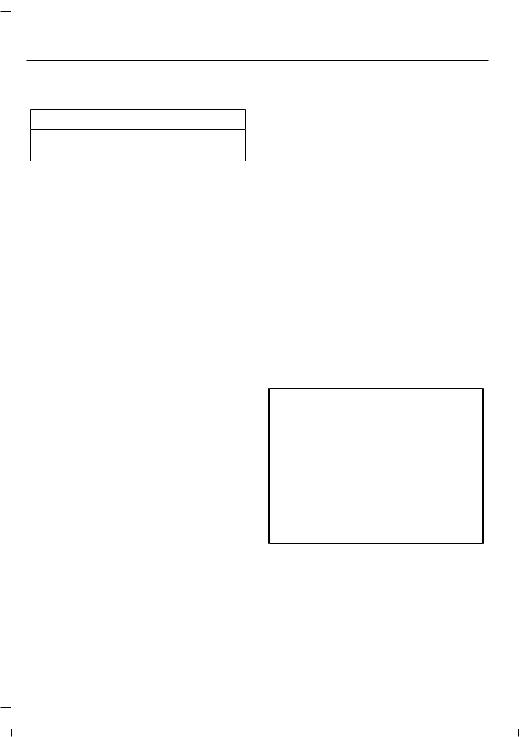
Introduction
For more information visit:
Web Address
www.dtsc.ca.gov/hazardouswaste/perchlorate
REPLACEMENT PARTS RECOMMENDATION
Warranty on Replacement Parts
Genuine Ford and Motorcraft replacement parts are the only replacement parts that benefit from a Ford Warranty. The Ford Warranty may not cover damage caused to your vehicle as a result of failed non-Ford parts. For additional information, refer to the terms and conditions of the Ford Warranty.
We have built your vehicle to the highest standards using quality parts. We recommend that you demand the use of genuine Ford and Motorcraft parts whenever your vehicle requires scheduled maintenance or repair. You can clearly identify genuine Ford and Motorcraft parts by looking for the Ford, FoMoCo or Motorcraft branding on the parts or their packaging.
Scheduled Maintenance and
Mechanical Repairs
One of the best ways for you to make sure that your vehicle provides years of service is to have it maintained in line with our recommendations using parts that conform to the specifications detailed in this Owner’s Manual. Genuine Ford and Motorcraft parts meet or exceed these specifications.
Collision Repairs
We hope that you never experience a collision, but accidents do happen. Genuine Ford replacement collision parts meet our stringent requirements for fit, finish, structural integrity, corrosion protection and dent resistance. During vehicle development we validate that these parts deliver the intended level of protection as a whole system. A great way to know for sure you are getting this level of protection is to use genuine Ford replacement collision parts.
16
SPECIAL NOTICES
New Vehicle Limited Warranty
For a detailed description of what is covered and what is not covered by your vehicle’s New Vehicle Limited Warranty, refer to the Warranty Manual that is provided to you along with your Owner’s Manual.
Special Instructions
For your added safety, your vehicle is fitted with sophisticated electronic controls.


2020 Transit (TTH) Canada/United States of America, LK3J 19A321 AA enUSA, Edition date: 201908, First-Printing
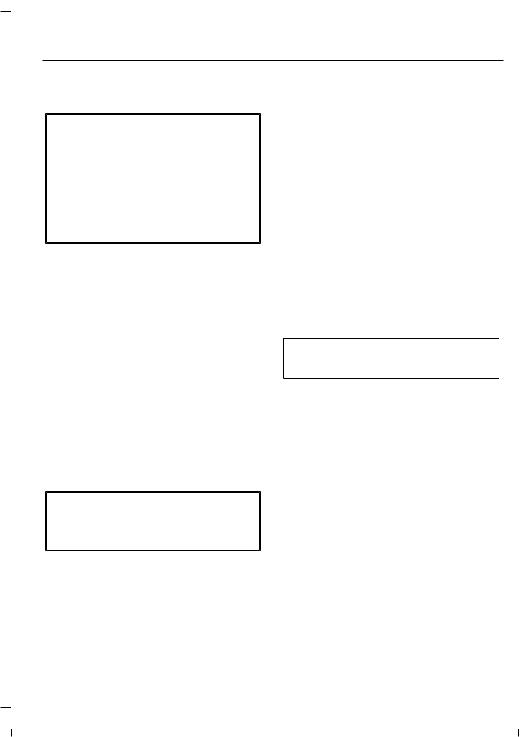
Introduction
On Board Diagnostics Data Link
Connector

Your vehicle has an OBD Data Link Connector (DLC) that is used in conjunction with a diagnostic scan tool for vehicle diagnostics, repairs and reprogramming services. Installing an aftermarket device that uses the DLC during normal driving for purposes such as remote insurance company monitoring, transmission of vehicle data to other devices or entities, or altering the performance of the vehicle, may cause interference with or even damage to vehicle systems. We do not recommend or endorse the use of aftermarket plug-in devices unless approved by Ford. The vehicle Warranty will not cover damage caused by an aftermarket plug-in device.
NoticetoOwnersofPickupTrucksand
Utility Type Vehicles

Before you drive your vehicle, please read this Owner’s Manual carefully. Your vehicle is not a passenger car. As with other vehicles of this type, failure to operate this vehicle correctly may result in loss of vehicle control, vehicle rollover, personal injury or death.
Using Your Vehicle With a Snowplow
Do not use this vehicle for snowplowing.
Your vehicle is not equipped with a snowplowing package.
Using Your Vehicle as an Ambulance
If your light truck is equipped with the Ford Ambulance Preparation Package, it may be utilized as an ambulance. Ford urges ambulance manufacturers to follow the recommendations of the Ford Incomplete Vehicle Manual, Ford Truck Body Builder’s Layout Book and the Qualified Vehicle Modifiers (QVM) Guidelines as well as pertinent supplements.
For additional information, please contact the Truck Body Builders Advisory Service:
Web Address
www.fleet.ford.com/truckbbas
You can also call us at
1–877–840–4338.
17
2020 Transit (TTH) Canada/United States of America, LK3J 19A321 AA enUSA, Edition date: 201908, First-Printing

Introduction
Other Vehicle Modifications
Ifconvertingormodifyingyourvehicle from production specification,refer to the Truck Body Builder Advisory website:
Web Address
www.fleet.ford.com/truckbbas
MOBILE COMMUNICATIONS EQUIPMENT

Using mobile communications equipment is becoming increasingly important in the conduct of business and personal affairs. However, you must not compromise your own or others’ safety when using such equipment. Mobile communications can enhance personal safety and security when appropriately used, particularly in emergency situations. Safety must be paramount when using mobile
communications equipment to avoid negating these benefits. Mobile communication equipment includes, but is not limited to, cellular phones, pagers, portable email devices, text messaging devices and portable two-way radios.
EXPORT UNIQUE OPTIONS
For your particular global region, your vehicle may be equipped with features and options that are different from the features and options that are described in this Owner’s Manual. A market unique supplement may be supplied that complements this book. By referring to the market unique supplement, if provided, you can properly identify those features, recommendations and specifications that are unique to your vehicle. This Owner’s Manual is written primarily for the U.S. and Canadian Markets. Features or equipment listed as standard may be different on units built for export. Refer to this Owner’s
Manual for all other required information and warnings.
18
2020 Transit (TTH) Canada/United States of America, LK3J 19A321 AA enUSA, Edition date: 201908, First-Printing

Environment
PROTECTING THE
ENVIRONMENT
You should play your part in protecting the environment. Correct vehicle usage and the authorized disposal of waste, cleaning and lubrication materials are significant steps toward this aim.
For additional information about our sustainability progress and initiatives, visit www.sustainability.ford.com.
19
2020 Transit (TTH) Canada/United States of America, LK3J 19A321 AA enUSA, Edition date: 201908, First-Printing
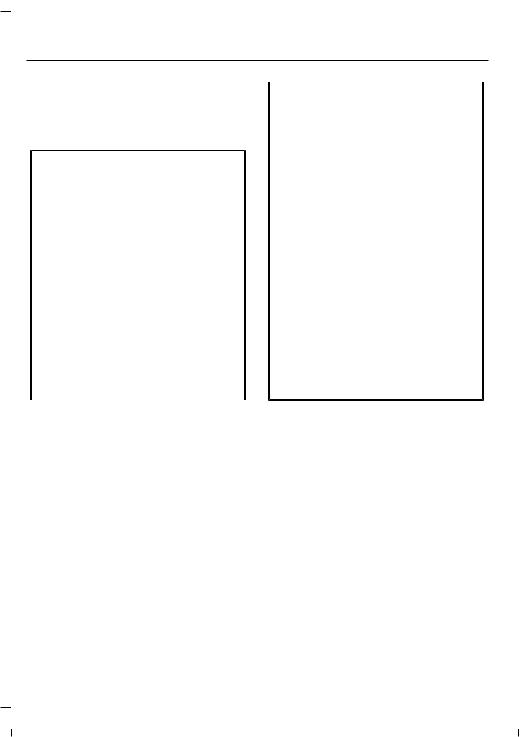
Child Safety
GENERAL INFORMATION
See the following sections for directions on how to properly use safety restraints for children.


20
(CPST) to make sure that you properly install the child restraint in your vehicle and that you consult your pediatrician to make sure you have a child restraint appropriate for your child. To locate a child restraint fitting station and CPST, contact NHTSA toll free at 1-888-327-4236 or go to www.nhtsa.dot.gov. In Canada, contact Transport Canada toll free at 1-800-333-0371 or go to www.tc.gc.ca to find a Child Car Seat Clinic in your area. Failure to properly restrain children in child restraints made especially for their height, age and weight, may result in an increased risk of serious injury or death to your child.

2020 Transit (TTH) Canada/United States of America, LK3J 19A321 AA enUSA, Edition date: 201908, First-Printing

Child Safety
Recommendations for Safety Restraints for Children
Child
Infants or toddlers
Small children
|
Child Size, Height, Weight, or Age |
Recommended Restraint |
|
|
Type |
||
|
Children weighing 40 lb (18 kg) or less |
Use a child restraint |
|
|
(sometimes called an |
||
|
(generally age four or younger). |
infant carrier, convertible |
|
|
seat, or toddler seat). |
||
|
Children who have outgrown or no longer |
||
|
properly fit in a child restraint (generally |
||
|
children who are less than 57 in (1.45 m) |
Use a belt-positioning |
|
|
tall, are greater than age four and less |
||
|
than age 12, and between 40 lb (18 kg) |
booster seat. |
|
|
and 80 lb (36 kg) and upward to 100 lb |
||
|
(45 kg) if recommended by your child |
||
|
restraint manufacturer). |
Children who have outgrown or no longer properly fit in a belt-positioning booster seat (generally children who are at least
Larger children 57 in (1.45 m) tall or greater than 80 lb (36 kg) or 100 lb (45 kg) if recommended
by child restraint manufacturer).
Use a vehicle seatbelt having the lap belt snug and low across the hips, shoulder belt centered across the shoulder and chest, and seat backrest
upright.
•You are required by law to properly use child restraints for infants and toddlers in the United States and Canada.
•Many states and provinces require that small children use approved booster seats until they reach age eight, a height of 57 in (1.45 m) tall, or 80 lb (36 kg). Check your local and state or provincial laws for specific requirements about the safety of children in your vehicle.
•When possible, always properly restrain children 12 years of age and under in a rear seating position of your vehicle. Accident statistics suggest that children are safer when properly restrained in the rear seating positions than in a front seating position.
•When installing a rear facing child restraint, adjust the vehicle seats to avoid interference between the child restraint and the vehicle seat in front of the child restraint.
21
2020 Transit (TTH) Canada/United States of America, LK3J 19A321 AA enUSA, Edition date: 201908, First-Printing
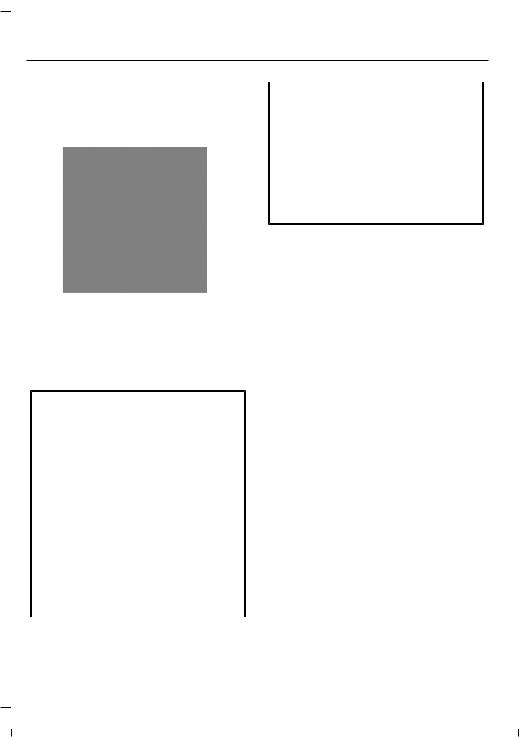
Child Safety
INSTALLING CHILD
RESTRAINTS
Child Safety Restraint
E142594
Use a child safety restraint (sometimes called an infant carrier, convertible seat, or toddler seat) for infants, toddlers, or children weighing 40 lb (18 kg) or less (generally age four or younger).
Using Lap and Shoulder Belts



When installing a child safety restraint with combination lap and shoulder belts:
•Use the correct seatbelt buckle for that seating position.
•Insert the belt tongue into the correct buckle until you hear a distinct click and feel it latch. Make sure the tongue is securely fastened in the buckle.
•Keep the buckle release button pointing up and away from the safety restraint, with the tongue between the child restraint and the release button, to prevent accidental unbuckling.
•Place the vehicle seat upon which the child restraint will be installed in the upright position.
•Put the seatbelt in the automatic locking mode. See Step 5. Your vehicle does not require the use of a locking clip.
Perform the following steps when installing the child restraint with combination lap and shoulder belts:
Note: Although the child restraint illustrated is a forward facing child restraint, the steps are the same for installing a rearward facing child restraint.
22
2020 Transit (TTH) Canada/United States of America, LK3J 19A321 AA enUSA, Edition date: 201908, First-Printing
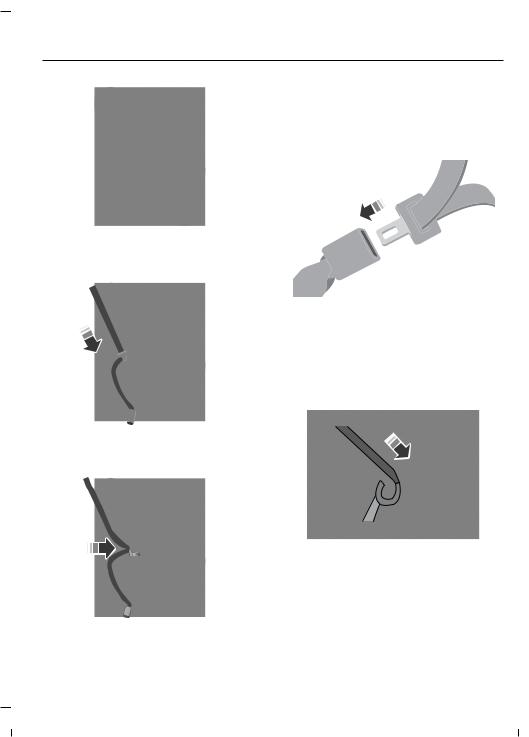
Child Safety
E142528
1.Position the child safety restraint in a seat with a combination lap and shoulder belt.
3.While holding the shoulder and lap belt portions together, route the tongue through the child restraint according to the child restraint manufacturer’s instructions. Make sure the belt webbing is not twisted.
E142529
2.Pull down on the shoulder belt and then grasp the shoulder belt and lap belt together.
E142530
E142531
4.Insert the belt tongue into the correct buckle (the buckle closest to the direction the tongue is coming from) for that seating position until you hear a distinct click and feel the latch engage. Make sure the tongue is latched securely by pulling on it.
E142875
5.To put the retractor in the automatic locking mode, grasp the shoulder portion of the belt and pull downward until all of the belt is pulled out.
Note: The automatic locking mode is available on the front passenger and rear seats.
23
2020 Transit (TTH) Canada/United States of America, LK3J 19A321 AA enUSA, Edition date: 201908, First-Printing

Child Safety
6.Allow the belt to retract to remove slack. The belt clicks as it retracts to indicate it is in the automatic locking mode.
7.Try to pull the belt out of the retractor to make sure the retractor is in the automatic locking mode (you should not be able to pull more belt out). If the retractor is not locked, unbuckle the belt and repeat Steps 5 and 6.
E142534
E142533
8.Remove remaining slack from the belt. Force the seat down with extra weight, for example, by pressing down or kneeling on the child restraint while pulling up on the shoulder belt. This is necessary to remove the remaining slack that exists once the extra weight of the child is added to the child restraint. It also helps to achieve the correct snugness of the child restraint to your vehicle. Sometimes, a slight lean toward the buckle helps to remove remaining slack from the belt.
9.Attach the tether strap (if the child restraint is equipped).
24
10.Before placing the child in the seat, forcibly move the seat forward and back to make sure the seat is securely held in place. To check this, grab the seat at the belt path and attempt to move it side to side and forward and back. There should be no more than 1 in (2.5 cm) of movement for correct installation.
We recommend checking with a NHTSA Certified Child Passenger Safety Technician to make certain the child restraint is correctly installed. In Canada, check with Transport Canada for referral to a Child Car Seat Clinic.
Using Lower Anchors and Tethers for Children (LATCH)

2020 Transit (TTH) Canada/United States of America, LK3J 19A321 AA enUSA, Edition date: 201908, First-Printing
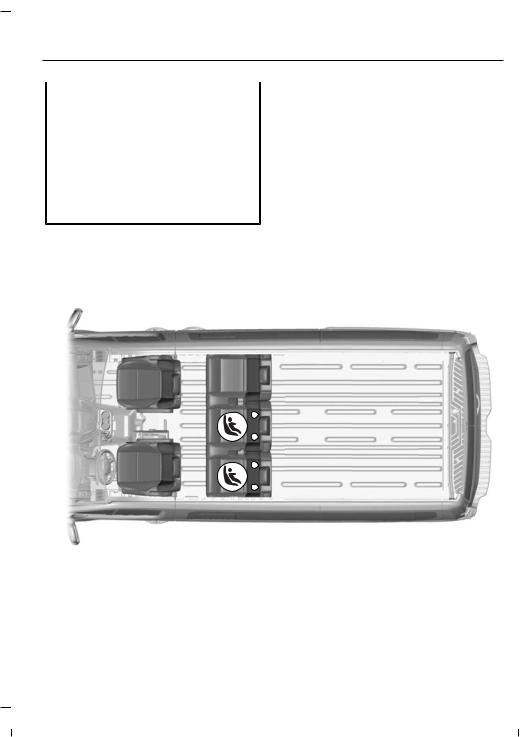
Child Safety

The LATCH system is composed of three vehicle anchor points: two lower anchors where the seat backrest and seat cushion meet (called the seat bight) and one top tether anchor behind that seating position.
LATCH compatible child safety restraints have two rigid or webbing mounted attachments that connect to the two lower anchors at the LATCH equipped seating positions in your vehicle. This type of attachment method eliminates the need to use seatbelts to attach the child restraint, however the seatbelt can still be used to attach the child restraint. For forward-facing child restraints, the top tether strap must also be attached to the correct top tether anchor, if a top tether strap has been provided with your child restraint.
2020 Transit (TTH) Canada/United States of America, LK3J 19A321 AA enUSA, Edition date: 201908, First-Printing
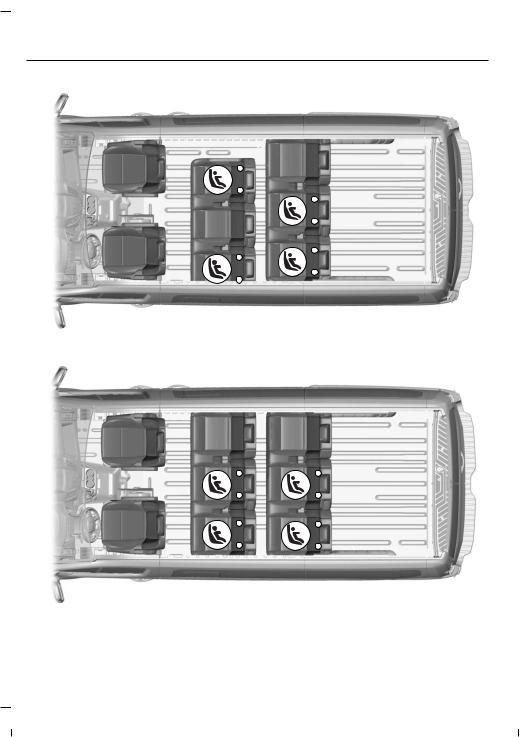
Child Safety
E258858
E254574
26
2020 Transit (TTH) Canada/United States of America, LK3J 19A321 AA enUSA, Edition date: 201908, First-Printing
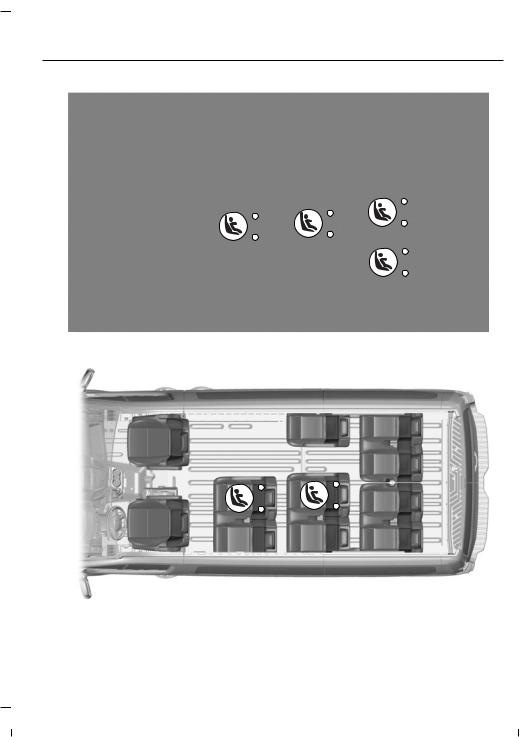
Child Safety
E258864
E282290
27
2020 Transit (TTH) Canada/United States of America, LK3J 19A321 AA enUSA, Edition date: 201908, First-Printing

Child Safety
E254575
E266915
28
2020 Transit (TTH) Canada/United States of America, LK3J 19A321 AA enUSA, Edition date: 201908, First-Printing

Child Safety
E254576
E258867
29
2020 Transit (TTH) Canada/United States of America, LK3J 19A321 AA enUSA, Edition date: 201908, First-Printing

Child Safety
Your vehicle has LATCH lower anchors for child restraint installation at the seating positions marked with the child restraint symbol.
Note: In addition to those shown, other seating positions may also have LATCH lower anchor points. You can identify these with the child restraint symbol shown on those seating positions.
E177639
The LATCH anchors are at the rear section of the rear seat between the cushion and seat backrest above the symbols as shown. Follow the child restraint manufacturer’s instructions to correctly install a child restraint with LATCH attachments. Follow the instructions on attaching child safety restraints with tether straps.
Attach LATCH lower attachments of the child restraint only to the anchors shown.
UseofInboardLowerAnchorsfromthe
Outermost Seating Positions (Center
Seating Use)

Do not attach a child restraint to any lower anchor if an adjacent child restraint is attached to that anchor.
Each time you use the safety restraint, check that the seat is correctly attached to the lower anchors and tether anchor, if applicable. Tug the child restraint from side to side and forward and back where it is secured to your vehicle. The seat should move less than 1 in (2.5 cm) when you do this for a correct installation.
If the safety restraint is not anchored correctly, the risk of a child being injured in a crash greatly increases.
Combining Seatbelt and LATCH Lower Anchors for Attaching Child Safety Restraints
When used in combination, either the seatbelt or the LATCH lower anchors may be attached first, provided a correct installation is achieved. Attach the tether strap afterward, if included with the child restraint.
30
2020 Transit (TTH) Canada/United States of America, LK3J 19A321 AA enUSA, Edition date: 201908, First-Printing

Child Safety
Using Tether Straps
Many forward-facing child safety restraints include a tether strap which extends from the back of
the child safety restraint and hooks to an anchoring point called the top tether anchor. Tether straps are available as an accessory for many older safety restraints.
Contact the manufacturer of your child restraint for information about ordering a tether strap, or to obtain a longer tether strap if the tether strap on the safety restraint does not reach the appropriate top tether anchor in your vehicle.
Once the child safety restraint has been installed using either the seatbelt, the lower anchors of the LATCH system, or both, you can attach the top tether strap.
The tether strap anchors in your vehicle are in the following positions (shown from top view):
2020 Transit (TTH) Canada/United States of America, LK3J 19A321 AA enUSA, Edition date: 201908, First-Printing

Child Safety
E311549
E258857
32
2020 Transit (TTH) Canada/United States of America, LK3J 19A321 AA enUSA, Edition date: 201908, First-Printing

Child Safety
E258859
E258865
33
2020 Transit (TTH) Canada/United States of America, LK3J 19A321 AA enUSA, Edition date: 201908, First-Printing

Child Safety
E282292
E258863
34
2020 Transit (TTH) Canada/United States of America, LK3J 19A321 AA enUSA, Edition date: 201908, First-Printing

Child Safety
E267027
E258866
35
2020 Transit (TTH) Canada/United States of America, LK3J 19A321 AA enUSA, Edition date: 201908, First-Printing

Child Safety
E258868
Perform the following steps to install a child safety restraint with tether anchors:
Note: If you install a child restraint with rigid LATCH attachments, do not tighten the tether strap enough to lift the child restraint off your vehicle seat cushion when the child is seated in it. Keep the tether strap just snug without lifting the front of the child restraint. Keeping the child restraint just touching your vehicle seat gives the best protection in a severe crash.
Front Passenger Seating Position
1.Adjust the front passenger seat fully forward.
2.Route the child safety restraint tether strap over the back of the seat, under the head restraint and between the head restraint posts.
36
2020 Transit (TTH) Canada/United States of America, LK3J 19A321 AA enUSA, Edition date: 201908, First-Printing

Child Safety
3. Locate the correct anchor on the back panel of the rear seat for the selected seating position. The anchors are labeled with the tether strap symbol and are partially covered by the gap panel. Pull the panel back to fully expose the anchors.
4. Clip the tether strap to the anchor as shown.
5. Adjust the front passenger seat fully rearward.
6. Tighten the child safety restraint tether strap according to the manufacturer’s instructions. If your child restraint system is equipped with a tether strap, and the child restraint manufacturer recommends its use, we also recommend its use.
Rear Seats
1. Route the child safety restraint tether strap over the back of the seat, under the head restraint and between the head restraint posts.
E178096
37
2020 Transit (TTH) Canada/United States of America, LK3J 19A321 AA enUSA, Edition date: 201908, First-Printing

Child Safety
E177640
2.Locate the correct anchor on the back panel of the rear seat for the selected seating position. The anchors are labeled with the tether strap symbol and are partially covered by the gap panel. Pull the panel back to fully expose the anchors.
3.Clip the tether strap to the anchor as shown.
4.Tighten the child safety restraint tether strap according to the manufacturer’s instructions. If your child restraint system has a tether strap, and the child restraint manufacturer recommends its use, we also recommend its use.
BOOSTER SEATS

Use a belt-positioning booster seat for children who have outgrown or no longer properly fit in a child safety restraint (generally children who are less than 57 in (1.45 m) tall, are greater than age 4 and less than age 12, and between 40 lb (18 kg) and 80 lb (36 kg) and upward to 100 lb (45 kg) if recommended by your child restraint manufacturer). Many state and provincial laws require that children use approved booster seats until they reach age eight, a height of 57 in (1.45 m) tall, or 80 lb (36 kg).
Booster seats should be used until you can answer YES to ALL of these questions when seated without a booster seat:
2020 Transit (TTH) Canada/United States of America, LK3J 19A321 AA enUSA, Edition date: 201908, First-Printing

Child Safety
•Can the child sit all the way back against their vehicle seat backrest with knees bent comfortably at the edge of the seat cushion?
•Can the child sit without slouching?
•Does the lap belt rest low across the hips?
•Is the shoulder belt centered on the shoulder and chest?
•Can the child stay seated like this for the whole trip?
Always use booster seats in conjunction with your vehicle lap and shoulder belt.
Types of Booster Seats
above the top of the seat. In this case, move the backless booster to another seating position with a higher seat backrest or head restraint and lap and shoulder belts, or consider using a high back booster seat.
E68924
•Backless booster seats
If your backless booster seat has a removable shield, remove the shield. If a vehicle seating position has a low seat backrest or no head restraint, a backless booster seat may place your child’s head (as measured at the tops of the ears)
E70710
•High back booster seats
If, with a backless booster seat, you cannot find a seating position that adequately supports your child’s head, a high back booster seat would be a better choice.
Children and booster seats vary in size and shape. Choose a booster that keeps the lap belt low and snug across the hips, never up across the stomach, and lets you adjust the shoulder belt to cross the chest and rest snugly near the center of the shoulder. The following drawings compare the ideal fit (center) to a shoulder belt uncomfortably close to the neck and a shoulder belt that could slip off the shoulder. The drawings also show how the lap belt should be low and snug across the child’s hips.
39
2020 Transit (TTH) Canada/United States of America, LK3J 19A321 AA enUSA, Edition date: 201908, First-Printing

Child Safety
E142596
E142597
If the booster seat slides on the vehicle seat upon which it is being used, placing a rubberized mesh sold as shelf or carpet liner under the booster seat may improve this condition. Do not introduce any item thicker than this under the booster seat. Check with the booster seat manufacturer’s instructions.
CHILD RESTRAINT
POSITIONING



40
2020 Transit (TTH) Canada/United States of America, LK3J 19A321 AA enUSA, Edition date: 201908, First-Printing

Child Safety
the child restraint manufacturer’s instructions and warnings provided for installation and use in conjunction with the instructions and warnings provided by your vehicle manufacturer. A safety seat that is improperly installed or utilized, is inappropriate for your child’s height, age, or weight or does not properly fit the child may increase the risk of serious injury or death.





41
2020 Transit (TTH) Canada/United States of America, LK3J 19A321 AA enUSA, Edition date: 201908, First-Printing

Child Safety
Recommendations for Attaching Child Safety Restraints for Children
|
Use Any Attachment Method as Indicated Below by X |
||||||
|
Combined |
LATCH |
LATCH |
Seatbelt |
Seatbelt |
Seatbelt |
|
|
Restraint |
Weight of |
(Lower |
(Lower |
and Top |
and LATCH |
Only |
|
Child and |
Anchors |
Anchors |
Tether |
(Lower |
||
|
Type |
||||||
|
Child |
and Top |
Only) |
Anchor |
Anchors |
||
|
Restraint |
Tether |
and Top |
||||
|
Anchor) |
Tether |
|||||
|
Anchor) |
||||||
|
Rear facing |
Up to 65 lb |
X |
X |
|||
|
child |
(29.5 kg) |
|||||
|
restraint |
||||||
|
Rear facing |
Over 65 lb |
X |
||||
|
child |
(29.5 kg) |
|||||
|
restraint |
||||||
|
Forward |
Up to 65 lb |
|||||
|
facing |
X |
X |
X |
|||
|
child |
(29.5 kg) |
|||||
|
restraint |
||||||
|
Forward |
Over 65 lb |
|||||
|
facing |
X |
X |
||||
|
child |
(29.5 kg) |
restraint
Note: The child restraint must rest tightly against the vehicle seat upon which it is installed. It may be necessary to lift or remove the head restraint. See Seats (page 128).
CHILD SAFETY LOCKS(IF
EQUIPPED)

E259284
The child safety lock is on the rear side door.
42
2020 Transit (TTH) Canada/United States of America, LK3J 19A321 AA enUSA, Edition date: 201908, First-Printing

Child Safety
Left-Hand Side
Turn the key counterclockwise to lock and clockwise to unlock.
Right-Hand Side
Turn the key clockwise to lock and counterclockwise to unlock.
43
2020 Transit (TTH) Canada/United States of America, LK3J 19A321 AA enUSA, Edition date: 201908, First-Printing

Seatbelts
PRINCIPLE OF OPERATION










All seating positions in this vehicle have lap and shoulder belts. All occupants of the vehicle should always properly wear their seatbelts, even when an airbag supplemental restraint system is provided.
The seatbelt system consists of:
•Lap and shoulder seatbelts.
•Shoulder seatbelt with automatic locking mode, (except driver seatbelt).
•Height adjuster at the front outboard seating positions.
•Seatbelt pretensioner at the front outboard seating positions.
44
2020 Transit (TTH) Canada/United States of America, LK3J 19A321 AA enUSA, Edition date: 201908, First-Printing

Seatbelts
•Seatbelt warning light and chime.
•Crash sensors and monitoring system with readiness indicator.
The seatbelt pretensioners at the front seating positions are designed to tighten the seatbelts when activated. In frontal and near-frontal crashes, the seatbelt pretensioners may be activated alone or, if the crash is of sufficient severity, together with the front airbags. In side crashes and rollovers, the seatbelt pretensioners activate when the Safety Canopy is activated.
FASTENING THE SEATBELTS
The front outermost and rear safety restraints in your vehicle are combination lap and shoulder belts.
E142588
2.Press the button to release the seatbelt tongue.
UsingSeatbeltsDuringPregnancy

E142587
1.Insert the seatbelt tongue into the proper buckle (the buckle closest to the direction the tongue is coming from) until you hear a snap and feel it latch.
Note: Make sure that the seatbelt tongue is properly fastened in the seatbelt buckle.
2020 Transit (TTH) Canada/United States of America, LK3J 19A321 AA enUSA, Edition date: 201908, First-Printing

Seatbelts
Pregnant women should always wear their seatbelt. The lap belt portion of a combination lap and shoulder belt should be positioned low across the hips below the belly and worn as tight as comfort allows. The shoulder belt should be positioned to cross the middle of the shoulder and the center of the chest.
Seatbelt Locking Modes


All seatbelts in your vehicle are combination lap and shoulder belts. The driver seatbelt has the first type of locking mode, and the front outermost passenger and rear seat seatbelts have both types of locking modes described as follows:
46
Vehicle Sensitive Mode
This is the normal retractor mode which allows free shoulder belt length adjustment to your movements and locking in response to vehicle movement. For example, if you brake suddenly or turn a corner sharply, or your vehicle receives an impact of approximately 5 mph
(8 km/h) or more, the combination seatbelts lock to help reduce forward movement of the driver and passengers.
In addition, the retractor is designed to lock if you pull the webbing out too quickly. If the seatbelt retractor locks, slowly lower the height adjuster to allow the seatbelt to retract. If the retractor does not unlock, pull the seatbelt out slowly then feed a small length of webbing back toward the stowed position. For rear seatbelts, recline the rear seat backrest or push the seat backrest cushion away from the seatbelt. Feed a small length of webbing back toward the stowed position.
Automatic Locking Mode
In this mode, the shoulder belt automatically pre-locks. The seatbelt still retracts to remove any slack in the shoulder belt. The automatic locking mode is not available on the driver seatbelt.
Using Automatic Locking Mode
You should use automatic locking mode when a child safety seat, except a booster, is on the front passenger seat or rear seat. Children 12 years old and under should be correctly restrained in a rear seating position whenever possible. See Child Safety (page 20).
2020 Transit (TTH) Canada/United States of America, LK3J 19A321 AA enUSA, Edition date: 201908, First-Printing

Seatbelts
E142591
1.Buckle the combination lap and shoulder belt.
2.Grasp the shoulder portion and pull downward until you pull the entire seatbelt out.
3.Let the seatbelt retract.
Note: As the seatbelt retracts, you will hear a clicking sound. This indicates the seatbelt is now in the automatic locking mode.
Disengaging Automatic Locking Mode
Unbuckle the combination lap and shoulder belt and allow it to retract completely to disengage the automatic locking mode and return the seatbelt to the vehicle sensitive mode.
SEATBELT HEIGHT
ADJUSTMENT

Failure to adjust the seatbelt correctly could reduce its effectiveness and increase the risk of injury in a crash.
1
2
2
3
E165022
1.Press the button.
2.Slide the height adjuster up or down.
3.Release the button and pull down on the height adjuster to make sure it is locked in place.
SEATBELT WARNING LAMP AND INDICATOR CHIME
This lamp illuminates and an
indicator chime will sound if the driver seatbelt has not been
fastened when the vehicle’s ignition is turned on.
47
2020 Transit (TTH) Canada/United States of America, LK3J 19A321 AA enUSA, Edition date: 201908, First-Printing






